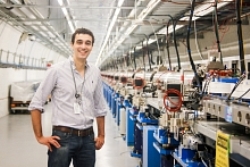Apr 21 2014
SLAC postdoctoral researcher Agostino Marinelli has received the Frank Sacherer Prize, an award presented by the European Physical Society to a young accelerator physicist in the early part of his or her career who has made "a recent significant, original contribution to the accelerator field."
 SLAC accelerator physicist Agostino Marinelli, shown here in the LCLS Undulator Hall, has been named 2014 recipient of the Frank Sacherer Prize by the European Physical Society in recognition of his considerable contributions to free-electron laser science at an early stage in his career.
SLAC accelerator physicist Agostino Marinelli, shown here in the LCLS Undulator Hall, has been named 2014 recipient of the Frank Sacherer Prize by the European Physical Society in recognition of his considerable contributions to free-electron laser science at an early stage in his career.
The award honors Marinelli's efforts to add additional capabilities to SLAC's Linac Coherent Light Source (LCLS). He has worked on two ways to create two-color beams, in which the intense, short pulses of X-ray light arrive at an experiment with two separate and easily distinguishable energies. Two-color beams enable some important types of experiments at LCLS that could not previously be performed, such as determining the structures of biological samples like proteins by using two different wavelengths of light. Another example: Studying how atomic systems and high-density clouds of charged particles, called plasmas, respond to a stimulus over time by using one color of X-ray light to excite a sample, with the second color probing it after a tiny delay.
Marinelli will travel to Dresden, Germany in June, where he will accept the prize, along with a 2,000-euro honorarium, at the 5th International Particle Accelerator Conference (IPAC). Awarded every three years to coincide with IPAC meetings in Europe, the Sacherer Prize is named after American accelerator physicist Frank Sacherer, who made several important contributions to accelerator physics during his time as a staff scientist at the European high-energy physics laboratory CERN.
Wide-ranging Interests
While the award recognized Marinelli's work at LCLS, he has also used SLAC's Next Linear Collider Test Accelerator, including a new method to pull important information about an electron beam out of a single bunch of electrons. This method, a type of single-shot diagnostics, uses techniques borrowed from X-ray diffraction imaging, which is usually used to determine the shape and atomic makeup of crystals.
"I like to work on both accelerators," Marinelli said. "They're both a lot of fun, and the people at both are great. At NLCTA I have a lot of freedom to do experiments that might not have useful results right away, but at LCLS the researchers need the work I do. They ask for it and start using it right away."
His desire to push boundaries and make a difference, said Marinelli, led to his focus on free-electron lasers (FELs) like LCLS. While at The Sapienza University of Rome, Marinelli met FEL pioneer Claudio Pellegrini through his advisor, Luigi Palumbo. Pellegrini is now at SLAC, but at the time was a professor at the University of California Los Angeles. Pellegrini and his colleague and frequent SLAC collaborator James Rosenzweig invited Marinelli to UCLA for his graduate work, and from there he joined SLAC.
"Agostino is a very brilliant young scientist," Pellegrini said. "He did some very nice work at NLCTA for his PhD – a novel technique for beam diagnosis– and he's been very active and productive on the LCLS work."
"Ago is definitely one of our brightest young scientists," said Zhirong Huang, co-leader of SLAC's FEL research and development program and Marinelli's supervisor. "In a very short time at SLAC, he has generated good ideas and tested them successfully in LCLS experiments. I have no doubt that he will continue to make important, original contributions to accelerator and FEL science."
Teamwork Counts
Pellegrini pointed out a second strength of Marinelli's.
"Ago is a very nice guy. He gets along with everyone," Pellegrini said. "It's important that young scientists like him can talk to the experimenters using LCLS and find out what they need, and that the experimenters feel comfortable asking for help from Ago. A teamwork approach like this is a very important factor in the success of LCLS experiments and he fits in well as a member of the team."